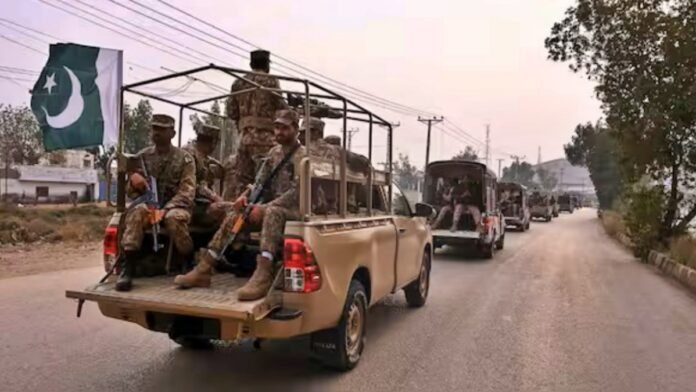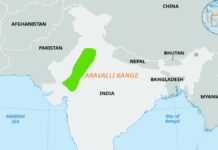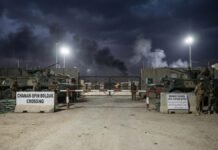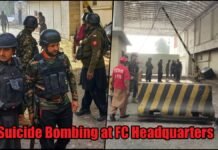
Key Points
- Eleven Pakistani paramilitary personnel killed in coordinated TTP ambush in Kurram district near Afghan border on Wednesday, October 8, 2025
- Nine soldiers and two officers killed when roadside IEDs hit convoy before large-scale militant gun attack
- Tehreek-e-Taliban Pakistan (TTP) claimed responsibility for the deadly assault in statement to Reuters
- Pakistani military conducted retaliatory operation in neighboring Orakzai district, killing 19 Islamist militants
- Over 900 people killed in Pakistan in past three months as terrorist attacks surge 46% compared to previous quarter
- 2,414 deaths recorded in 2025 so far nearly matching entire 2024 total with three months still remaining
- 329 violent incidents including militant attacks and military operations occurred in last quarter
- Kurram district remains volatile hotspot with repeated militant assaults in recent years
- TTP has intensified attacks on Pakistani security forces in recent months, seeking to overthrow government
- Islamabad accuses militants of using Afghanistan for training; Pakistan also alleges Indian financial support—both countries deny claims
- Army’s Inter-Services Public Relations (ISPR) did not immediately respond to requests for comment
- Security forces launched search operation to track down attackers following the ambush
New Delhi: In one of the deadliest attacks on Pakistani security forces in recent months, eleven paramilitary personnel, including two officers, were killed in a sophisticated ambush by Tehreek-e-Taliban Pakistan (TTP) militants in the volatile Kurram district near the Afghan border on Wednesday, October 8, 2025. The coordinated assault, involving roadside improvised explosive devices (IEDs) followed by intense gunfire, underscores the resurgent terrorism threat plaguing Pakistan’s northwestern regions and the growing boldness of Islamist militant groups operating near the Afghanistan frontier.
Coordinated Attack: IEDs Followed by Heavy Gunfire
The deadly ambush unfolded when a paramilitary convoy traveling through the northwestern district of Kurram was struck by roadside bombs, immediately incapacitating vehicles and causing casualties among the troops. Five Pakistani security officials, speaking to Reuters on condition of anonymity, confirmed that the initial IED explosions were followed by a large-scale gun attack launched by a substantial contingent of militants who had positioned themselves strategically along the convoy route.
The well-planned nature of the assault suggests extensive reconnaissance and preparation by the attackers, who timed the detonation of explosive devices to maximize casualties before unleashing automatic weapons fire on the disabled convoy. The tactical sophistication demonstrated in the attack combining explosives to halt movement with coordinated small arms fire reflects the military training and combat experience possessed by TTP fighters.
Nine paramilitary soldiers and two officers lost their lives in the brutal assault, while several other personnel sustained injuries and were evacuated to a nearby military hospital for emergency medical treatment. The casualties represent a significant blow to Pakistani security forces already stretched thin by multiple insurgent threats across the country’s northwestern frontier.
TTP Claims Responsibility for Deadly Assault
The Tehreek-e-Taliban Pakistan (TTP), also known as the Pakistani Taliban, swiftly claimed responsibility for the deadly ambush in a statement provided to a Reuters correspondent. The militant organization, which has been waging an insurgency against the Pakistani state for nearly two decades, confirmed that its fighters carried out the coordinated attack on the paramilitary convoy.
The TTP’s public acknowledgment of the assault reflects the group’s confidence and its strategic objective of demonstrating continued operational capability despite sustained pressure from Pakistani military operations. By claiming responsibility, the organization seeks to project strength to potential recruits, intimidate security forces, and undermine public confidence in the government’s ability to provide security.
The Pakistani Taliban, distinct from but ideologically aligned with the Afghan Taliban, has been intensifying attacks on Pakistani security forces in recent months as part of its stated objective to overthrow the current government and replace it with their hardline interpretation of Islamic governance. The group’s resurgence represents one of the most serious security challenges facing Pakistan, with violence levels approaching those not seen since the height of the insurgency over a decade ago.
Pakistani Military Conducts Retaliatory Strike, Kills 19 Militants
In response to the deadly ambush, the Pakistani army announced that it conducted a major counter-terrorism operation in the neighboring Orakzai district, resulting in the elimination of 19 Islamist militants. The operation, described in an official army statement, appears to represent a swift retaliatory strike designed to demonstrate the military’s capability to respond forcefully to attacks on its personnel.
The timing and scale of the operation announced the same day as the Kurram ambush suggests it may have been a planned offensive that was either already underway or rapidly launched in direct response to the paramilitary convoy attack. Pakistani security forces frequently conduct operations in the tribal districts bordering Afghanistan, targeting suspected militant hideouts and training camps.
However, the Army’s Inter-Services Public Relations (ISPR) wing, which serves as the military’s official spokesperson, did not immediately respond to requests for comment specifically regarding the Kurram district ambush. This silence has left many details about the attack, including the specific paramilitary unit targeted and the circumstances leading to such high casualties, unclear.
Alarming Surge in Violence: Over 900 Killed in Three Months
The deadly Kurram ambush occurs against a backdrop of sharply escalating violence across Pakistan, with terrorism-related deaths surging to levels not seen in years. According to a comprehensive report released Monday by the Centre for Research and Security Studies (CRSS) in Islamabad, at least 901 people were killed and 599 injured in 329 incidents of violence—including militant attacks and Pakistani army operations during the past three months alone.
This represents a staggering 46% increase compared to the previous quarter, signaling a dangerous escalation in the intensity and frequency of terrorist attacks across the country. The sharp uptick in casualties reflects both the increasing boldness of militant groups and the Pakistani military’s expanded counter-terrorism operations aimed at degrading insurgent capabilities.
Perhaps most alarmingly, Pakistan has already recorded 2,414 deaths in 2025 through early October—nearly matching the entire year 2024 total of 2,546 deaths, with three months still remaining in the current year. Security experts and analysts predict that if current trends continue, 2025 could become one of Pakistan’s deadliest years in over a decade, potentially surpassing even the peak violence levels of the mid-2010s.
The concentration of violence in Pakistan’s northwestern regions, particularly the tribal districts bordering Afghanistan, reflects the strategic importance of this terrain to militant groups and the persistent challenge Pakistani security forces face in controlling these remote, mountainous areas.
Kurram District: A Persistent Terrorism Hotspot
The Kurram district, where Wednesday’s deadly ambush occurred, has long been identified as one of Pakistan’s most volatile and dangerous regions. Located in Khyber Pakhtunkhwa province directly adjacent to the Afghan border, Kurram has experienced repeated militant assaults in recent years, making it a focal point of Pakistan’s counter-terrorism efforts.
The district’s geographic position makes it strategically significant for militant groups, providing access routes between Afghanistan and Pakistan’s interior, rugged terrain that facilitates guerrilla warfare tactics, and a complex tribal social structure that can sometimes shield insurgents from security forces. The area has also been plagued by sectarian violence, further complicating security dynamics and providing additional opportunities for militant groups to exploit communal tensions.
Security experts emphasize that Wednesday’s attack represents a clear indication that the terrorism problem is resurging in Pakistan’s northwestern region, with militant groups demonstrating renewed capability to conduct sophisticated, coordinated operations against well-defended military targets. The pattern of attacks in Kurram and surrounding districts suggests that insurgent groups maintain established networks, safe houses, and local support structures that enable sustained operations despite military pressure.
Recent Pattern of Escalating Attacks
The Kurram ambush is merely the latest in a series of deadly assaults targeting Pakistani security forces across the country’s northwestern frontier . Just last month in September 2025, twelve soldiers were martyred in an attack in South Waziristan, another volatile tribal district, for which the TTP also claimed responsibility . That incident, like Wednesday’s attack, demonstrated the militants’ preference for ambush tactics targeting convoys and the effectiveness of these methods in inflicting casualties on security forces .
The frequency and lethality of recent attacks indicate that the TTP and allied militant groups have reconstituted their operational capabilities following a period of relative quiet, and are now conducting an organized campaign of violence against Pakistani targets. The tactical sophistication displayed in these assaults combining explosives, coordinated small arms fire, and strategic positioning—suggests that militants have access to training, weapons, and intelligence that enable them to effectively engage professional military forces.
TTP’s Objectives and Ideology
The Tehreek-e-Taliban Pakistan remains committed to its fundamental objective of overthrowing the Pakistani government and imposing its strict interpretation of Islamic law across the country. The group, formed in 2007 as an umbrella organization of various Pakistani militant factions, has waged a brutal insurgency characterized by attacks on security forces, government officials, and civilians deemed non-compliant with their ideology.
Despite suffering significant setbacks during major Pakistani military operations in 2014-2015 that drove many fighters into Afghanistan, the TTP has demonstrated resilience and has been rebuilding its capabilities in recent years. The return of the Afghan Taliban to power in Afghanistan in August 2021 has been viewed by many analysts as providing the Pakistani Taliban with increased operational space and potential safe haven, though the Afghan Taliban government officially denies supporting cross-border militancy.
The TTP’s recent intensification of attacks suggests the organization believes it possesses sufficient strength to challenge Pakistani security forces and that the current regional environment provides opportunities to advance its agenda. The group’s ability to conduct high-casualty attacks with apparent impunity raises serious questions about the effectiveness of Pakistan’s counter-terrorism strategy and the government’s ability to neutralize this persistent threat.
Pakistan-Afghanistan Border Tensions
A major source of friction between Islamabad and Kabul centers on Pakistan’s accusation that TTP militants use neighboring Afghanistan to train and plan attacks against Pakistani targets. Pakistani officials have repeatedly claimed that militant sanctuaries exist on Afghan territory, providing safe haven where fighters can rest, regroup, and prepare operations before crossing into Pakistan to conduct attacks.
The Afghan government categorically denies these allegations, maintaining that Afghan soil will not be permitted to be used against any other country. This diplomatic impasse has complicated efforts to address cross-border militancy and has strained relations between the two neighbors, despite their shared interest in regional stability.
Adding another layer of complexity to the situation, the Pakistani army statement regarding the Orakzai operation included allegations that the country’s long-standing rival, India, provides financial support and backing to militant groups operating against Pakistan. Both India and Afghanistan have firmly denied these accusations, dismissing them as unfounded propaganda designed to deflect attention from Pakistan’s domestic security failures.
The accusations and counter-accusations between regional powers highlight the geopolitical dimensions of Pakistan’s terrorism challenge and the difficulty of forging cooperative counter-terrorism approaches when trust is absent and competing interests dominate regional relationships.
Security Response and Ongoing Operations
Immediately following Wednesday’s deadly ambush, Pakistani security forces cordoned off the Kurram district attack site and launched a comprehensive search operation aimed at tracking down and apprehending the attackers. Such operations typically involve deploying additional troops to the area, establishing checkpoints to prevent militant escape, conducting house-to-house searches in nearby villages, and gathering intelligence from local populations.
However, the challenging terrain of Kurram district characterized by rugged mountains, narrow valleys, and limited road networks significantly complicates pursuit operations and provides numerous concealment opportunities for fleeing militants. Historically, attackers in this region have frequently managed to evade immediate capture by quickly dispersing into difficult terrain or crossing the nearby Afghan border.
The lack of an official statement from the Army’s Inter-Services Public Relations (ISPR) department regarding the Kurram attack is notable, as ISPR typically issues prompt statements about significant security incidents. The silence may indicate that military leadership is still assessing the situation, coordinating a response strategy, or addressing internal concerns about the security lapses that allowed such a deadly ambush to occur.
Implications for Pakistan’s Security Situation
Wednesday’s attack carries significant implications for Pakistan’s overall security environment and the government’s counter-terrorism strategy. The ability of militant groups to conduct coordinated, high-casualty attacks on military convoys—despite years of counter-terrorism operations and billions of dollars spent on security infrastructure raises fundamental questions about the sustainability of current approaches.
The 46% increase in violence over the past three months and the likelihood that 2025 will become one of Pakistan’s deadliest years in a decade suggest that militant groups have successfully adapted to military pressure and have reconstituted their capabilities. This resilience indicates that purely military solutions may be insufficient and that comprehensive strategies addressing the ideological, economic, and governance dimensions of militancy are necessary.
For Pakistani security forces, the pattern of ambush attacks targeting convoys highlights the persistent challenge of protecting personnel during routine operations in hostile environments. The tactical advantage enjoyed by attackers who can choose the time and place of engagement, combined with the difficulty of defending moving convoys in mountainous terrain, creates inherent vulnerabilities that militants have learned to exploit effectively.
Regional and International Dimensions
Pakistan’s terrorism challenge exists within a complex regional context that includes the security transition in Afghanistan, tensions with India, great power competition involving China and the United States, and broader concerns about Islamist militancy across South Asia. The resurgence of attacks by the TTP and allied groups represents not merely a domestic Pakistani security problem but a regional stability concern with implications for Afghanistan, India, and potentially Central Asia.
The international community has watched Pakistan’s escalating violence with concern, particularly given the country’s nuclear weapons arsenal and the risk that sustained instability could have catastrophic consequences. Western governments have long urged Pakistan to take decisive action against militant groups operating on its territory, while offering varying levels of support for counter-terrorism efforts.
However, the complexity of Pakistan’s security environment involving multiple militant groups with different objectives, external sanctuaries in Afghanistan, sectarian dimensions, tribal dynamics, and resource constraints—makes formulating and implementing effective counter-terrorism strategies enormously challenging. Wednesday’s deadly ambush in Kurram district serves as a stark reminder that despite years of military operations and thousands of casualties, Pakistan’s battle against terrorism remains far from resolved.
As security forces conduct operations in response to the attack and search for the perpetrators, Pakistani citizens and security personnel brace for the possibility of additional violence in what has already become one of the country’s deadliest years in recent memory. The path forward requires not only military operations but comprehensive strategies addressing the root causes of militancy, improving governance in vulnerable regions, and forging regional cooperation to deny militants cross-border sanctuaries.

















































